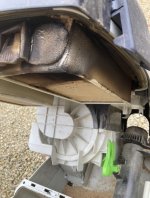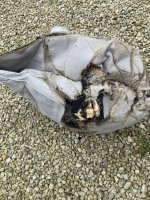WastedP said:
Because of the fire in the hole, I opened up the vac to see if anything was going on in there, and that's when I decided the disposable bag was way overfull. It probably weighed 20+ pounds. I changed the bag and went back to work, and I can say that you are 100% right, the difference in dust removal was night and day. I doubt enough tinder would've built up if I had changed it prior.
Yep, this is one of the few instances where an M-class vac (with a flow sensor set to D36 hose when using D27 one) or a CT-VA where one can see how it is full are a godsend.
Having a CT-VA as well as M-class with sensor. I would rather have a CT-VA with a non-sensor CTL to having a CTM with no CT-VA. I need to change the bag so little, that I know when the bag is close to 80% reliably just by opening it every other month or so.
OT
-------
Agree on earlier comment how a DD works the same. It would, with the exception you cannot easily see how full it is unless you invest a lot into a clear bin. So either a lot of opening the bin, or you end up with a full bag all the same.
The reason the CT-VA is so expensive is, in no small part, due to the clear bin being included - that bin alone costs $70 and there is a reason for that cost. It needs to be able to handle the vacuum so there goes a lot of R&D and a lot of quality material to it. Then there are the custom systainer pieces which are 1/2 the cost. If you do not care for these - DD does not provide them after all - then just get the AS cyclone unit for $90 and DYI it the same way a DD would need to be DYIed.
To use the CT-VA cyclone unit itself, all one needs is a wooden box or a bin with a circular hole in the top plus a couple pieces of ply to pressure-hold the top in place. Not much different to a DD integration setup. And you get an anti-static cyclone to boot. If you like to DYI, that is.
What you get for $390 is a complete system which is plug & play. The DD Deluxe does offer that at $140. But it is not anti-static and is incomparably bulky. In a big shop with lots of space, or when one needs high air volume (DD 2.5 is definitely better there). Sure. It has its place on the market and I think going 2.5 was a great move by Oneida. *)
But it would be good if folks stopped pretending DD is some great value compared to the CT-VA. It is not. It is a low-end product made of cheap materials with minimum to no R&D effort **) and no integration in the design whatsoever. As that, it is reasonably priced. The same way the CT-VA is reasonably priced for what it provides. As a whole product.
This is the same way that buying raw construction lumber is a "better value" when you need it for a roof design where the twisting of it drying does not matter, being accounted for. Sure, they are cheaper. But they are not the same thing as the pre-dried beams. Each is cost-optimal for their own use cases.
*) I am writing this from where the average income is 1/2 the one in the US and the disposable one even less than that. So this is no "Richman's Perspective" like some seem to presume.
**) A basic cone cyclone separator geometry is a well-known thing. No need to invent anything. The CT-VA, on the other hand, uses a pretty complex flow design to allow it being compact but still get good separation rates. One cannot build such a thing without some serious flow simulation R&D work.

